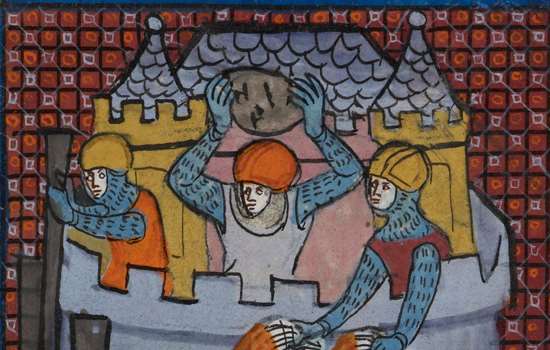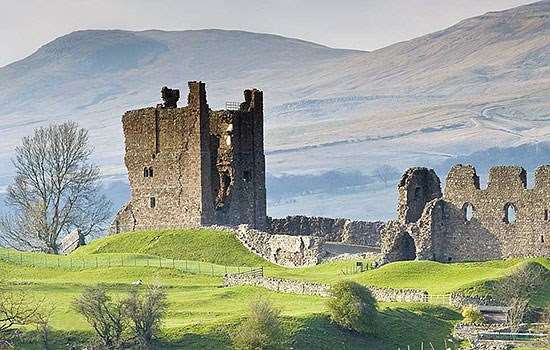War with the barons
In the mid 1260s England was divided by civil war. Henry III, who had been on the throne since 1216, was at loggerheads with some of his leading nobles, who wanted to reform how the king governed. Their leader was the king’s brother-in-law, Simon de Montfort, Earl of Leicester, who defeated the king’s forces at the Battle of Lewes in 1264 and captured both Henry III and his elder son, Edward. He held the king captive for 15 months before he was himself defeated and killed in August 1265 at the Battle of Evesham by Edward, who had escaped captivity.
Many of Montfort’s supporters fought on after his death, and Henry had to deal with uprisings across the country. The rebels had one key asset: Kenilworth Castle.
This mighty fortress, lying at the heart of England, was one of the largest in the kingdom. It had been a royal castle, and King John, Henry’s father, had spent vast sums strengthening and expanding its outer defences, which included a giant mere or lake. In 1253 Henry III had given it to Montfort for life, probably hoping to secure his loyalty.
Preparing for siege
By giving away one of his most heavily fortified castles, Henry had taken a huge risk – as soon became apparent after Evesham, when it became a focus for resistance. He attempted to persuade the garrison to surrender, but they refused all his overtures. The harsh treatment of Montfort’s defeated supporters after Evesham probably convinced the garrison that they would be better off waiting for reinforcements to arrive from France, or that in prolonging their resistance they might be in a stronger position to bargain with the king.
Montfort’s son, also called Simon, was forced to promise to give Kenilworth back to the king when Prince Edward captured him in early 1266. But on seeing how badly Henry treated with the younger Simon, the rebels inside the castle felt they still had nothing to lose by resisting the king.
Henry’s patience finally snapped after his messenger to them in March 1266 returned with a severed hand. The only way for the king to reclaim the castle was by force.
By the time the royal forces assembled at Kenilworth Castle, the garrison – men, women, children and servants, numbering over 1,200 people – had built up stocks of enough food to hold out for months. They had access to siege engines, according to a contemporary chronicler, ‘hitherto unheard of among us and unseen’, which the late Simon de Montfort had acquired. Determined to retake the castle, the king had also amassed a huge arsenal of weaponry – including 2,000 wooden ‘hurdles’ (timber screens to protect the royal soldiers from missiles), 60,000 crossbow bolts and nine siege engines.
The siege begins
On 25 June 1266 an all-out siege began.
The king’s stone-throwing machines, erected all around the castle, bombarded it with a continuous stream of missiles. They were thwarted, however, by the superior range of the weaponry inside – one chronicler described the stone projectiles from the two sides ‘clashing in the air’. The king had to send to London for larger machines. One of his wooden siege towers, apparently containing 200 crossbowmen and attached to the walls of the castle, was rendered useless by a well-aimed missile.
The water defences were preventing the royal forces from undermining the castle walls, so the king had barges hauled overland from Chester for a waterborne assault across the mere. But the defenders managed to repel them.
Last stand
Henry, by now desperate to restore his prestige and authority, called a parliament near the castle in October, which resulted in the peace terms known as the Dictum of Kenilworth, issued on 31 October. This allowed for the rebels to regain their forfeited lands on payment of heavy fines (up to seven times the annual income of those lands). However, the garrison rejected these conditions as too harsh, and vowed to fight on.
The siege wore on for a further six weeks. But in the end, as Henry ordered further forces to prepare to storm the castle, disease and starvation brought about what the siege had failed to. On 14 December the remnants of the garrison submitted to the terms they had been offered in October. They were allowed to leave with their arms, horses and harness. Only two days’ supply of food remained in the castle, and the garrison had been severely weakened by dysentery.
The siege’s outcome
At 172 days, Kenilworth’s was one of the longest sieges in English medieval history. What did it achieve?
For Henry, Kenilworth Castle was at least restored to him. He immediately gave it to his younger son, Edmund, who was made Earl of Lancaster the following year – so beginning about 200 years of the castle’s ownership by the House of Lancaster.
In terms of establishing peace, however, the siege achieved little. The victorious royalists behaved vindictively towards their opponents, who quickly started up trouble elsewhere. When the civil war between Henry and his barons finally ended nearly a year later, it was the result of political compromise.
The siege was also ruinously expensive, leaving Henry so short of money that he had to pawn the jewels from the shrine of King Edward the Confessor in Westminster Abbey.
But perhaps the siege’s greatest impact was on the young Lord Edward, who succeeded his father in 1272 as Edward I. At Kenilworth Castle he had seen the full array of the latest weaponry pitted against a formidable modern fortress, in a type of warfare refined by crusaders in the Middle East and in the gruelling conflict between the Plantagenets and the kings of France.
It may well have been this direct experience of how castles worked that informed his thinking in time for the crusades he embarked on in 1270 and his great castle-building (and besieging) campaigns from 1277 onwards in Wales and Scotland.
Find out more
-

HISTORY OF KENILWORTH CASTLE
Read a comprehensive overview of the history of the castle, from its Norman origins through its long connection with many English monarchs.
-

Medieval Siege Warfare
Explore some of the artillery and devices and the complex strategies for attack and defence used in medieval siege warfare before gunpowder weapons were invented.
-

A Cross-Dressing Medieval Spy at Kenilworth
Discover the story of Margoth, Henry III’s cross-dressing female spy, and what light it sheds on both cross-dressing and espionage in medieval England.
-

Eleanor de Montfort and the Siege of Dover Castle
Caught up at the centre of a civil war, Eleanor de Montfort held Dover Castle against the king in 1265 after her husband and eldest son were killed in battle.
-

Buy the guidebook
This comprehensive guidebook includes a tour and history of the house, with many reconstruction drawings and historical images.
-

Medieval Castles
Discover the stories held within the walls of England’s greatest fortifications and learn about the rise and fall of the medieval castle.
